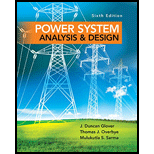
Concept explainers
The “Ohm’s law” for the magnetic circuit states that the net magnetomotive force (mmf) equals the product of the core reluctance and the core flux.
(a) True
(b) False
Whether the given statement is true or false.
Answer to Problem 3.1MCQ
The given statement is true. The correct option is (a).
Explanation of Solution
Magneto-motive force is analogous to electro-motive force, magnetic flux is analogous to electric current and magnetic reluctance is analogous to electric resistance.
So ohm law for magnetic circuit can be stated as "magnetic flux produced in magnetic circuit is directly proportional to magneto-motive force".
Therefore,
Simplify above equation.
Rearrange above equation.
Here,
So net magneto-motive force equal the product of core reluctance and core flux.
Thus, the given statement is true. The correct option is (a).
Want to see more full solutions like this?
Chapter 3 Solutions
Power System Analysis and Design (MindTap Course List)
- Three single-phase, two-winding transformers, each rated 450MVA,20kV/288.7kV, with leakage reactance Xeq=0.10perunit, are connected to form a three-phase bank. The high-voltage windings are connected in Y with a solidly grounded neutral. Draw the per-unit equivalent circuit if the low-voltage windings are connected (a) in with American standard phase shift or (b) in Y with an open neutral. Use the transformer ratings as base quantities. Winding resistances and exciting current are neglected.arrow_forwardThe ideal transformer windings are eliminated from the per-unit equivalent circuit of a transformer. (a) True (b) Falsearrow_forwardConsider the oneline diagram shown in Figure 3.40. The three-phase transformer bank is made up of three identical single-phase transformers, each specified by X1=0.24 (on the low-voltage side), negligible resistance and magnetizing current, and turns ratio =N2/N1=10. The transformer bank is delivering 100 MW at 0.8 p.f. lagging to a substation bus whose voltage is 230 kV. (a) Determine the primary current magnitude, primary voltage (line-to-line) magnitude, and the three-phase complex power supplied by the generator. Choose the line-to-neutral voltage at the bus, Va as the reference Account for the phase shift, and assume positive-sequence operation. (b) Find the phase shift between the primary and secondary voltages.arrow_forward
- The direct electrical connection of the windings allows transient over voltages to pass through the auto transfonner more easily, and that is an important disadvantage of the autotransformer. (a) True (b) Falsearrow_forwardThree single-phase two-winding transformers, each rated 25MVA,54.2/5.42kV, are connected to form a three-phase Y- bank with a balanced Y-connected resistive load of 0.6 per phase on the low-voltage side. By choosing a base of 75 MVA (three phase) and 94 kV (line-to-line) for the high-voltage side of the transformer bank, specify the base quantities for the low-voltage side. Determine the per-unit resistance of the load on the base for the low-voltage side. Then determine the load resistance RL in ohms referred to the high-voltage side and the per-unit value of this load resistance on the chosen base.arrow_forwardThe leakage reactance of a three-phase, 300-MVA,230Y/23-kV transformer is 0.06 per unit based on its own ratings. The Y winding has a solidly grounded neutral. Draw the per-unit equivalent circuit. Neglect the exciting admittance and assume the American Standard phase shift.arrow_forward
- The per-unit equivalent circuit of two transformers Ta and Tb connected in parallel, with the same nominal voltage ratio and the same reactan of 0.1 per unit on the same base, is shown in Figure 3.43. Transformer Tb has a voltage-magnitude step-up toward the load of 1.05 times that of Ta (that is, the tap on the secondary winding of Tb is set to 1.05). The load is represented by 0.8+j0.6 per unit at a voltage V2=1.0/0 per unit. Determine the complex power in per unit transmitted to the load through each transformer, comment on how the transformers share the real and reactive powers.arrow_forwardFor developing per-unit equivalent circuits of single-phase three-winding transformer, a common Sbase is selected for all three windings and voltage bases are selected in proportion to the rated voltage of the windings (a) True (b) Falsearrow_forwardFor an ideal 2-winding transformer, the ampere-turns of the primary winding, N1I1 is equal to the ampere-turns of the secondary winding, N2I2 (a) True (b) Falsearrow_forward
- Consider three ideal single-phase transformers (with a voltage gain of ) put together as three-phase bank as shown in Figure 3.35. Assuming positive-sequence voltages for Va,Vb, and Vc find Va,Vb, and VC. in terms of Va,Vb, and Vc, respectively. (a) Would such relationships hold for the line voltages as well? (b) Looking into the current relationships, express IaIb and Ic in terms of IaIb and Ic respectively. (C) Let S and S be the per-phase complex power output and input. respectively. Find S in terms of S.arrow_forwardUsing the transformer ratings as base quantities, work Problem 3.13 in per-unit.arrow_forwardA bank of three single-phase transformers, each rated 30MVA,38.1/3.81kV, are connected in Y- with a balanced load of three 1, Y-connected resistors. Choosing a base of 90MVA,66kV for the high-voltage side of the three-phase transformer. spify the base for the low-voltage side. Compute the per-unit resistance of the load on the base for the low-voltage side. Also, determine the load resistance in ohms referred to the high-voltage side and the per-unit value on the chosen base.arrow_forward
 Power System Analysis and Design (MindTap Course ...Electrical EngineeringISBN:9781305632134Author:J. Duncan Glover, Thomas Overbye, Mulukutla S. SarmaPublisher:Cengage Learning
Power System Analysis and Design (MindTap Course ...Electrical EngineeringISBN:9781305632134Author:J. Duncan Glover, Thomas Overbye, Mulukutla S. SarmaPublisher:Cengage Learning
